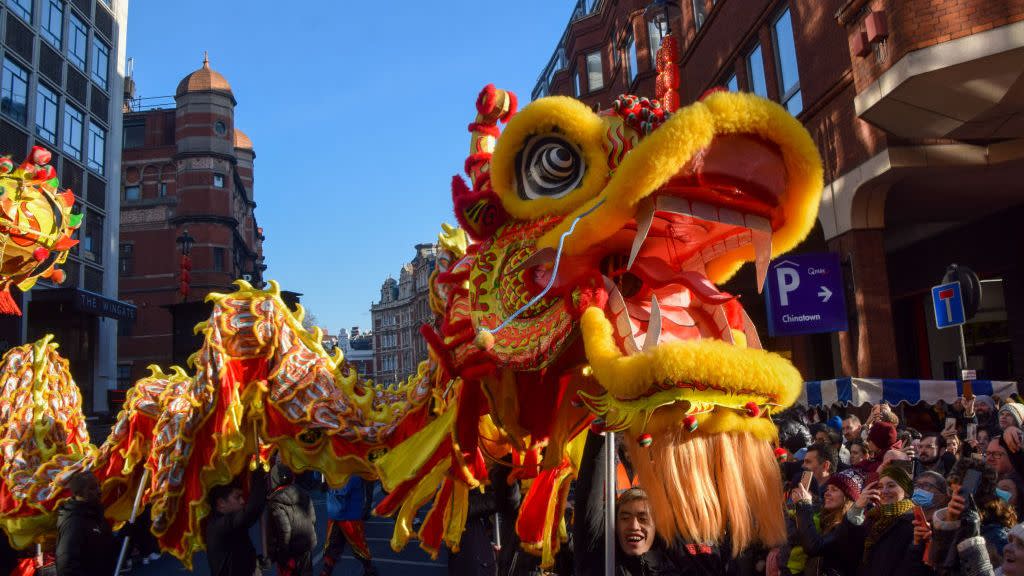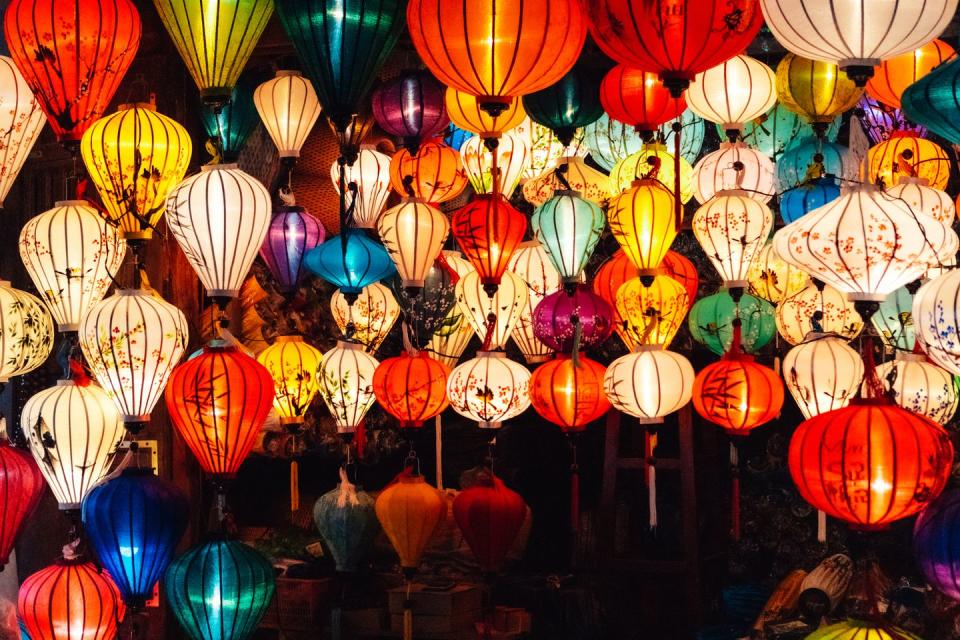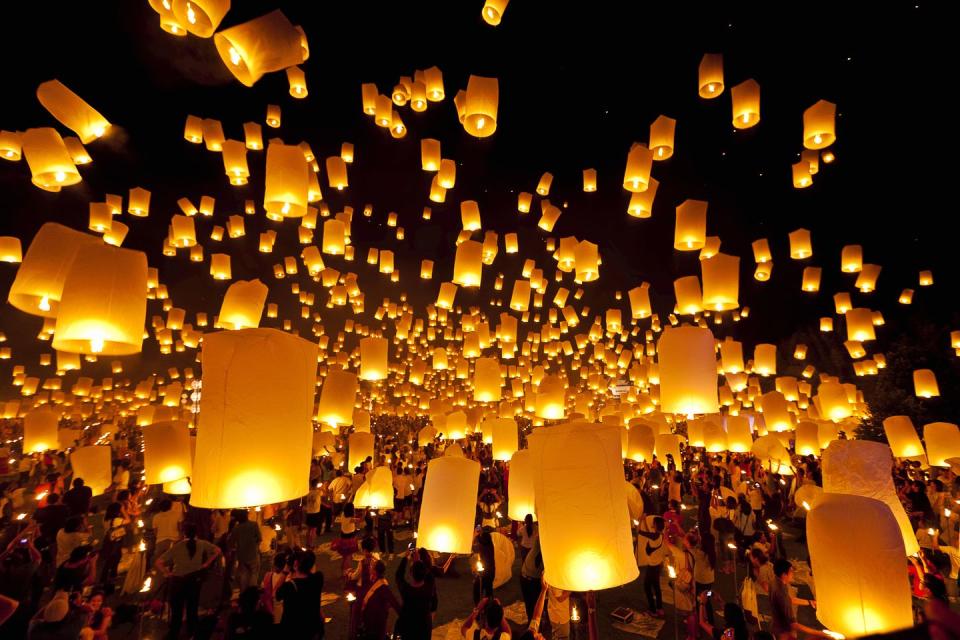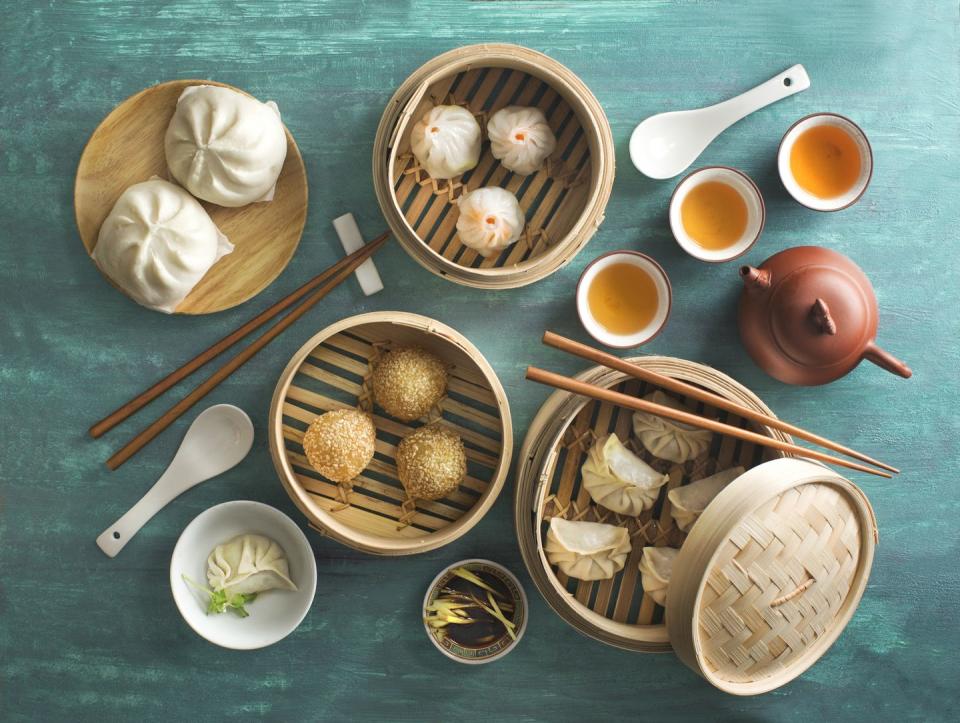Welcome the Year of the Dragon With These Lunar New Year Traditions

Lunar New Year is an important annual holiday celebrated by many people of Asian descent around the world. This year, Lunar New Year, also known as Chinese New Year, begins on February 10, and can be celebrated for up to 15 days. “Just as Christmas is a highlight of the year for many Western people, so is the Spring Festival, or Lunar New Year, to the Chinese all over the world,” says Dr. Jianguo Chen, an associate professor of Chinese at the University of Delaware.
This year is the Year of the Dragon, which is a powerful sign associated with authority, strength and good fortune. The only mythical animal in the Chinese zodiac, dragons are known as particularly special, which makes this year (and previous 12 year cycles of the Chinese Zodiac) a desirable year for babies to be born. You’ll see many traditions that emphasize the dragon theme in greetings, decorations and more.
What is Lunar New Year?
Originally an agricultural holiday, Lunar New Year commemorates the end of winter and the beginning of spring, which is why it is also known as the “Spring Festival.” The traditions of this holiday celebration often align with themes of revival, renewal and rejuvenation. Communities celebrate the holiday through many traditions—with each culture, family or individual choosing which custom they would like to adopt. From hosting a big family dinner, gifting red envelopes filled with cash, going to parades that showcase customary lion and dragon dances and hanging decorations with symbolic meaning, there is something for everyone.
This holiday is thought to have originated during China’s Shang Dynasty that dates back to 1600 BCE, so Lunar New Year traditions are based on history, symbolism, superstition and myth that have been passed down through generations. One major theme for every Lunar New Year is luck: that is, attracting good luck and avoiding bad luck for the year ahead.
Whether you’re an immigrant, Asian American or an ally, Lunar New Year is a perfect opportunity to refresh your goals for the coming year. After all, Lunar New Year is about starting with a clean slate, cleansing the negative, welcoming the positive and setting intentions for a prosperous, lucky and fulfilling year. Set yourself up for good luck this upcoming Year of the Dragon by starting anew with a positive mindset and joining in on some of the following Lunar New Year traditions.

What are the traditions of Lunar New Year?
Over thousands of years, people celebrating Lunar New Year developed many practices that help start the year fresh, usher in good luck and ward off bad luck. Each country and every individual celebrates Lunar New Year a little bit differently with distinctive traditions, foods and festivities, but here are a few of the most common.
Cleaning house
It makes sense to welcome in a new era with a cleanse, and those who celebrate Lunar New Year often prepare for the holiday by cleaning their houses from top to bottom “It is customary for people to completely clean their houses to get rid of bad fortune from the old year,” says Chen.
For some, cleaning before the Lunar New Year is important — they consider it bad luck to clean during the 15-day celebration. They believe that the good luck of Lunar New Year begins at midnight on the first day and consider it unlucky to clean until the end of the holiday. However, the tradition varies widely with some people actually dedicating the entire first day of Lunar New Year to cleaning and organizing their homes.
Decorating with red
Lunar New Year is a holiday with vivid visual power, so much so that its celebratory decor can be easily identified by visitors from both outside and inside the home. In China, after cleaning, people decorate their houses with the color red in the form of festive scrolls, folk painting, paper-cuts and lanterns. “Bright red is the preeminent color of festivity, symbolic of good health and fortune, wealth, prosperity and longevity,” he says. Decorations are usually ornate with splashes of red, gold embellishments, and lucky symbols, often including the year’s zodiac animal. With 2024 being the Year of the Dragon, many decorations will incorporate a dragon motif in playful and creative ways. It is an especially fun year to decorate for Lunar New Year because you can make this mythical creature that can fly, hang and flutter the centerpiece of your festivities.
Paying off debts and avoiding borrowing or lending money
Another important tradition: Cementing your financial fortune for the upcoming year by paying off your debts prior to the first day of Lunar New Year, and making sure not to borrow or lend money during the 15-day celebration. Superstition says that handling money through borrowing or lending during Lunar New Year might lead to financial struggles in the year ahead.
Not cutting or changing your hair
The Chinese character for “hair” is the same as the first character in the word for “prosper.” Some say that cutting or changing your hair on the first day or even first month of the new Lunar year is like throwing or washing away your fortune. Many limit this superstition to the first day of the holiday, and just avoid washing or cutting their hair, or even showering, on new year’s day.
Giving and receiving red envelopes
In pop culture, nothing signifies Lunar New Year more than little red envelopes adorned in gold and stuffed with cash. During a visit to older relatives, people are usually gifted money in these red envelopes, known as Hónɡ bāo in China. In the Philippines, the red envelopes are called Ang Pao and Vietnam calls them “Li xi,” or “lucky money.” In Korea, however, money from the elders called Sae bae don, translated as “new year’s money,” is usually given not in red but in white or patterned envelopes.
Buying new clothes
What’s a better way to put the “new year, new you” attitude into action than a refreshed wardrobe? During Lunar New Year, some people purchase new everyday clothing to symbolize a clean slate and attract good luck, while others buy new traditional clothing to wear when they visit family. In Korea, people wear traditional garb called Hanbok for formal occasions and holidays, including Lunar New Year. Women’s Hanbok consists of a long skirt and a short jacket in colorful patterns and lustrous materials. In China, women can wear Qípáo or Cheongsam, a high-necked and often short-sleeved dress, for the holiday. The holiday can be a good opportunity (and excuse) for a New Year’s shopping spree.

Not buying or giving books
The Chinese word for “book” is pronounced the same way as the word “lose,” so some believe that buying books for yourself or others can forecast bad luck for the upcoming year. But not to worry, bibliophiles! You can buy and gift as many books before and after the 15-day celebration, and there are no rules around reading the books you already have.
Being kind and generous and avoiding fights or arguments
They say that what happens on the first day of the new lunar year sets the tone for the year ahead. Being your best self and speaking kindly of yourself and others brings good luck for the year. Avoid directing negative language or energy toward others on this first day (and all days!) because it could mean you’re in for a year of relationship issues and draining arguments, and nobody has the time for that. Watch your words when talking about others or yourself, especially avoiding ones related to death, killing, poverty or illness—traditions say foregoing these terms can help shield yourself and your loved ones from tragedy and misfortune in the upcoming year.
Watching Lion and Dragon Dances at the lantern festival
In China, Lunar New Year ends with the Lantern Festival, a celebration that includes folk dancing, traditional games, lantern parades and dragon and lion dances. While the lions in these dances symbolize strength and stability, dragons are paragons that exude power and excellence. These dances are meant to welcome in luck and prosperity and chase away negative energy. According to Chen, in China, the Lantern Festival is sometimes known as China’s Valentine’s Day, where singles hope to meet their new flame. The festive ambience makes for a romantic atmosphere and the symbolism of the dances could certainly embolden those to pursue a love interest.
Setting off firecrackers at night and staying up late
“Setting off firecrackers is an important part of the Chinese New Year and also of the Lantern Festival,” says Chen. Launched right after midnight on the first day of Chinese New Year—much like the New Year’s Eve Times Square ball drop in New York City—pyrotechnics certainly start the new year off with a literal bang. In China, firecrackers are also known to be a way to ward off evil and bad luck, according to the Timothy S. Y. Lam Museum of Anthropology. Chinese legend has it that there was a mythical beast named Nian that would prowl after the New Year, but the loud noises and bright sparks of fireworks scared it away. As part of their Lunar New Year’s celebration, some people stay up all night after the fireworks, or stay up until just after the midnight fireworks, since vigilant people pulling all-nighters stood guard against the evil spirit.
Offering greetings
While we greet people in January with a basic “Happy New Year” in the U.S., various Asian countries have different sayings in their respective languages. In Korea, to honor elders, people say “Saehae bok mani badeuseyo,” which means, “Please receive a lot of good fortune for the New Year.” Chen says that in China, people greet each other with phrases like “Gōng xǐ fā cái” in Mandarin and “Gung hei faat coi” in Cantonese, which mean “Wishing you a happy and prosperous Chinese New Year.” In Vietnam, people say, “Chúc mừng năm mới,” which simply means “Happy New Year” in Vietnamese.
Connecting with family
Like any major holiday, Lunar New Year is a time to spend time with loved ones, especially grandparents and older relatives.“Typically, on the first day of the festival, people would pay a visit to their elderly and respected,” says Chen. Family can be complicated, so Lunar New Year is an opportunity to clear the air with relatives. “It is a special occasion for people to express good wishes to each other and to forgive, leaving behind all grudges and animosity from the old year,” says Chen.
Traveling back home for family reunion dinner
Like the Thanksgiving and Christmas travel rush in the United States, flying back home to visit family during Lunar New Year is a common practice. Travel guides often warn of congested streets and overbooked international flights during the period,” says Chen.
But it’s a trip that can pay off with the warm comfort of home, family, and good food. Chen says, “Coming from different parts of the globe, several generations of family gather to eat the family reunion dinner, catch up and reminisce during Lunar New Year. If you can’t make it to see your family in person, a phone call, Facetime or virtual celebration is a must.
What foods are traditionally eaten for Lunar New Year?
Like many holidays around the world, Lunar New Year is celebrated with delicious foods and feasts. “Holidays are about eating, and the Spring Festival [in China] is particularly so,” says Chen. Foods eaten during this holiday are often symbolically charged with biddings of good luck, longevity, and health. Each country, community and family has its own Lunar New Year delicacies, but here are a few common ones you might taste.
Dumplings
While some associate moon cakes with Lunar New Year, the delicacy is actually used for the Mid-Autumn Festival. Dumplings, or Jiǎozi in Mandarin, are a staple for Lunar New Year celebrations. “Since the shape of Jiǎozi looks like gold ingots used as currency in the Ming dynasty (1368-1644), eating Jiǎozi, so it was believed folklorically, would bring prosperity,” says Chen. “Some parents would even hide a big clean coin inside a Jiǎozi for the lucky kid to find as a table game on Chinese New Year’s Eve.”

Rice Cake Soup
For Seollal, Korea’s Lunar New Year, Koreans eat Tteokguk, literally translated as “rice cake soup.” The savory soup is made with thin disk-shaped rice cakes that resemble coins, which symbolize prosperity. In Korea, they say you get one year older when you eat a bowl of rice cake soup. The dish, which is made with water, small chunks of beef, green onion, egg, and rice cakes, is predominantly white in color, which signifies purity and new beginnings.
Glutinous Rice Balls
Lunar New Year, especially for Chinese communities, is also associated with delicious and versatile glutinous rice balls, called Yuánxiāo or Tāngyuán. These tiny, round and often sweet treats are generously stuffed with various fillings like black sesame, peanuts, red bean, rose petals and rock sugar.
Long Noodles
In some parts of China, people eat Chángshòu Miàn, which are known as “long-life noodles” or “longevity noodles.” These noodles can be as long as two feet and are served uncut, either fried or submerged in a broth. Symbolically, the longer the noodle you eat, the longer you’ll live. According to superstition, take care not to cut the noodle while cooking so you don’t accidentally cut your lifeline short.
You Might Also Like

